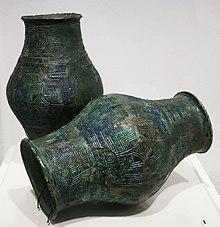Archaeological Hegau Museum

The Archaeological Hegau Museum is an archaeological museum in the Baden-Württemberg town of Singen (Hohentwiel) in Germany .
It shows the 15,000-year development of man and the environment from the last Ice Age of the Paleolithic to the early Middle Ages . The museum, an institution of the city of Singen, is housed in the historic Singen Castle.
collection
The museum goes back to the pharmacist Albert Funk from Singen , who carried out archaeological excavations since 1925 and documented and collected the sometimes spectacular finds . The archaeological collection has been on public display in the rooms of Singen Castle since 1951. Complemented by loans from the state of Baden-Württemberg, the museum presents prehistory and early history in south-west Germany in 13 rooms . The museum also offers a wide range of educational opportunities for children and school classes.
The presentation of the collection is divided into several time periods.
Stone age
Paleolithic hunters and gatherers kept coming back to the Hegau 15,000 years ago . The Petersfels Cave near Engen is an outstanding find . Many of the finds unearthed there can be seen in the Hegau Museum. The Neolithic is represented by finds from Hilzingen , among other things . At least sixteen longhouses were inhabited by farming families. Their legacies make it clear how agriculture and animal husbandry changed the way people live.
Bronze age
Dealing with metal was an important discovery for mankind. Copper and bronze were the first metals used. Very early evidence of this cultural change was discovered in the northern part of Singen, and experts speak of the Singen culture . The Atlantic daggers shown in the Hegau Museum are outstanding evidence of this. Numerous graves of the following centuries with their metal and ceramic objects attest to the continued prosperity.
Iron age
The museum shows many finds from the era of the Celts , which is represented in the exhibition with both subsections, the Hallstatt period and the Latène period . It starts with the so-called Singen sword , one of the first iron finds in southern Germany. In addition, the Alb-Hegau ceramics , which can also be seen in the Hegau Museum, are particularly important for the Iron Age .
Roman Imperial Era
The arm of Rome also reached into the Hegau. Many Roman manors have already been excavated or at least proven here. The Roman estate of Büßlingen was completely examined. Components of the Roman underfloor heating , a so-called hypocaust heating , ceramics, jewelry, tools and a coin treasure hidden at the time can be seen in the Hegau Museum.
Alemanni of the early Middle Ages
The Alemanni were the founders of numerous southwest German cities and villages. In Singen, an Alemannic cemetery was excavated on the station forecourt. The most beautiful grave goods are exhibited in the Hegau Museum. The inventory of the grave of a noble lady from Güttingen is certainly extraordinary : necklaces with millefiori pearls , vessels, gold jewelry and a Coptic bowl that found its way from Egypt to the Hegau.
literature
- Information sheets for teachers. Periods of the Stone Age, Bronze Age, Iron Age, Roman Age, Alemannic Age, themes of house and settlement forms, ceramics, jewelry, forms of burial, archeology. Hegau Museum, Singen 1990.
- Jörg Aufdermauer; Alfred Georg Frei: Hegau Museum, Singen (Hohentwiel). Magazinpresse, Munich 1987, ISBN 3-921114-91-8 .
Web links
Coordinates: 47 ° 45 ′ 45 ″ N , 8 ° 50 ′ 2 ″ E

